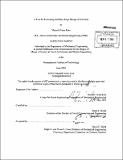| dc.contributor.advisor | Mark S. Welsh. | en_US |
| dc.contributor.author | Kara, Mustafa Yasin | en_US |
| dc.contributor.other | Massachusetts Institute of Technology. Dept. of Mechanical Engineering. | en_US |
| dc.date.accessioned | 2011-03-24T20:19:38Z | |
| dc.date.available | 2011-03-24T20:19:38Z | |
| dc.date.copyright | 2010 | en_US |
| dc.date.issued | 2010 | en_US |
| dc.identifier.uri | http://hdl.handle.net/1721.1/61872 | |
| dc.description | Thesis (S.M. in Naval Architecture and Marine Engineering)--Massachusetts Institute of Technology, Dept. of Mechanical Engineering, 2010. | en_US |
| dc.description | Cataloged from PDF version of thesis. | en_US |
| dc.description | Includes bibliographical references (p. 140). | en_US |
| dc.description.abstract | In naval architecture terminology, the term "corvette" refers to a class of ships that are shorter than frigates and longer than patrol boats. Corvettes have always been the centerpiece of the navies whose mission requirements are based on littoral combat such as Anti-Submarine Warfare, Mine Warfare, and Anti-Surface Warfare. Numerous studies have focused on frigates and patrol boats in the history of naval architecture. However, few studies applied to corvettes. There is a trend in the ship building industry to design new ships as corvettes [1] since they can operate both independently and in joint missions. However, it is difficult for a naval architect to manage all the information flow throughout the corvette design process. When the displacement of the ship gets larger, this design process also becomes more complicated. The management of this process becomes more efficient by using computer programs. However, programs for use in the design of corvettes do not exist. This thesis explains how early-stage estimations are made for corvettes. In order to cover this future trend in marine transportation, a MatlabTM model for the estimation of the main characteristics of corvettes in the early-stage design is also developed. This MatlabTM model is based on a statistical analysis of existing ships that are classified as corvettes. The database used in this study is created by using the public information that is available to the author. For this study, design lanes are created, trend lines are drawn and relationships between the desired values are graphed. For the validation of the code, the Kral J Petar Kresimir, Eilat (SAAR 5) and Robinson are used as reference ships in this study. The customer requirements of these ships are entered into the model. The results show that the data of these ships fall within the design lanes. | en_US |
| dc.description.statementofresponsibility | by Mustafa Yasin Kara. | en_US |
| dc.format.extent | 176 p. | en_US |
| dc.language.iso | eng | en_US |
| dc.publisher | Massachusetts Institute of Technology | en_US |
| dc.rights | M.I.T. theses are protected by
copyright. They may be viewed from this source for any purpose, but
reproduction or distribution in any format is prohibited without written
permission. See provided URL for inquiries about permission. | en_US |
| dc.rights.uri | http://dspace.mit.edu/handle/1721.1/7582 | en_US |
| dc.subject | Mechanical Engineering. | en_US |
| dc.title | A tool for evaluating the early-stage design of corvettes | en_US |
| dc.type | Thesis | en_US |
| dc.description.degree | S.M.in Naval Architecture and Marine Engineering | en_US |
| dc.contributor.department | Massachusetts Institute of Technology. Department of Mechanical Engineering | |
| dc.identifier.oclc | 705942066 | en_US |
